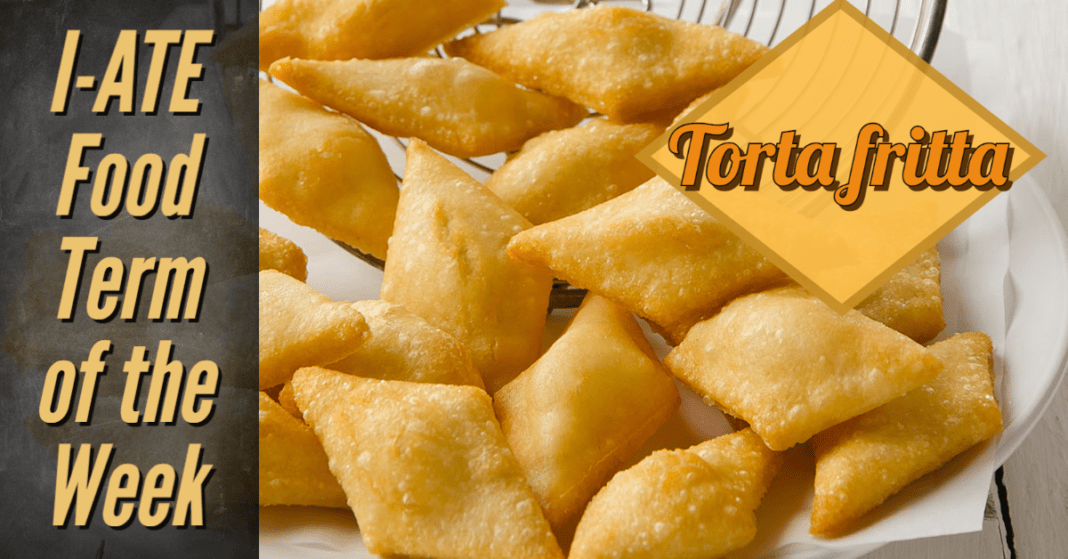Crispy yet soft light pillows of fried dough
Torta fritta is a delicious appetizer typical of the Emilia Romagna region in the north of Italy. It is usually paired with cured meats and cheese, served during family gatherings, local fairs, and other special occasions. Torta fritta can be served as an appetizer or a main dish; it is very tasty even as dessert, with Nutella or powdered sugar! It is a must-to-try: easy to make and authentically Italian!
This crispy yet soft pillow is made of flour, water, yeast, and lard. The yeast-based dough is rolled into a thin sheet, cut into diamond shapes, and fried until puffed and golden. Traditionally, strutto (pork fat) is used in the dough and for deep-frying.
According to the experts, torta fritta is best fresh and hot from the fryer, where it puffs up like down pillows, fluffed for bedtime. Its exterior crispness rivals with the satisfaction you get from cracking into the delicious Prosciutto di Parma.
This dish is meant to be eaten with an assortment of salumi, cold cuts like Prosciutto di Parma, mortadella, spalla cotta, or soft, spreadable cheese, like Squacquerone and Gorgonzola. By travelling through the region, you might realize that everyone has their own method of eating torta fritta, be it topping the fried puff open-faced, folding one in half or even making a sandwich. In Emilia Romagna, the most popular wine is Lambrusco, which makes the perfect couple with torta fritta, equilibrating its fried flavours with a sparkling taste.
The appetizer is an excellent example of the evolution of Northern-Italian cuisine. Rooted back in the Roman time, the recipe is the perfect mixture of Italian and Germanic cuisine, characterised by the use of lard and the frying technique.
Indeed, in 568–569 a Germanic tribe, called Lombards, invaded Italy under their king Alboin. They came from Pannonia (modern western Hungary) which was a Roman province itself. The invasion introduced new habits and other changes in the north of Italy. Regarding the local eating habits, the invaders introduced pork meat in the Italian peasants’ diet. Under this influence the local farmers started to fry little pieces of bread dough in melted lard and went on doing so for centuries. Torta fritta was the daily food of the farmers until the 60’s. Nowadays it is a product that is also used in major restaurants and it has become a special delicacy, served for Sunday lunches, special gatherings, and festivals.
Recipe:
- 250 grams of white flour
- 15 gr of beer yeast
- 30 gr of lard or oil
- 1 tablespoon filled with salt
- 1/8 l of lukewarm water (12 tablespoons)
- oil or lard for frying
The delicious fried dough puffs are very popular in Emilia Romagna region. Depending on the town or village, torta fritta takes on different names:
– Crescentine in Bologna;
– Chisolino in Piacenza;
– Gnocco fritto in Reggio Emilia and in the Modena areas;
– Pinzino in Ferrara.
But why is it called torta fritta in Parma?
In this area, the puffy dough was eaten with sugar and served as a dessert. This explains the use of the word torta, “cake” in English. During the 1900s, torta fritta started to accompany cold cuts and cheese. A sweet-salty delicacy that perfectly marries the local products. The name has remained, but torta fritta is now rarely eaten as a sweet.
We could find similar recipes in Spain. Coquetes fregides are a typical dish in the province of Alicante. These fried pancakes look-alikes can be eaten with sugar on top, together with coffee or hot chocolate. They are also served with sausages, or anchovies and cheese.
Some squares of torta fritta, Parmesan cheese or a slice of Prosciutto di Parma, a glass of Lambrusco, and the magic is done.
References:
Mirto, S. (2021). Gnocco fritto: Ricetta originale emiliana e segreti passo passo! [online] Tavolartegusto.it. Available at: https://www.tavolartegusto.it/ricetta/gnocco-fritto-ricetta-originale/.
Sala, F. (n.d.). ‘Gnocco fritto’ o ‘Torta fritta’ ? [online] madeinparma.com. Available at: https://madeinparma.com/it/news/gnocco-fritto-o-torta-fritta.
Turkell, M.H. (2018). Gnocco Fritto. [online] TASTE. Available at: https://tastecooking.com/recipes/gnocco-fritto/.
Encyclopedia Britannica. (n.d.). Italy – Lombards and Byzantines. [online] Available at: https://www.britannica.com/place/Italy/Lombards-and-Byzantines.
Written by:


